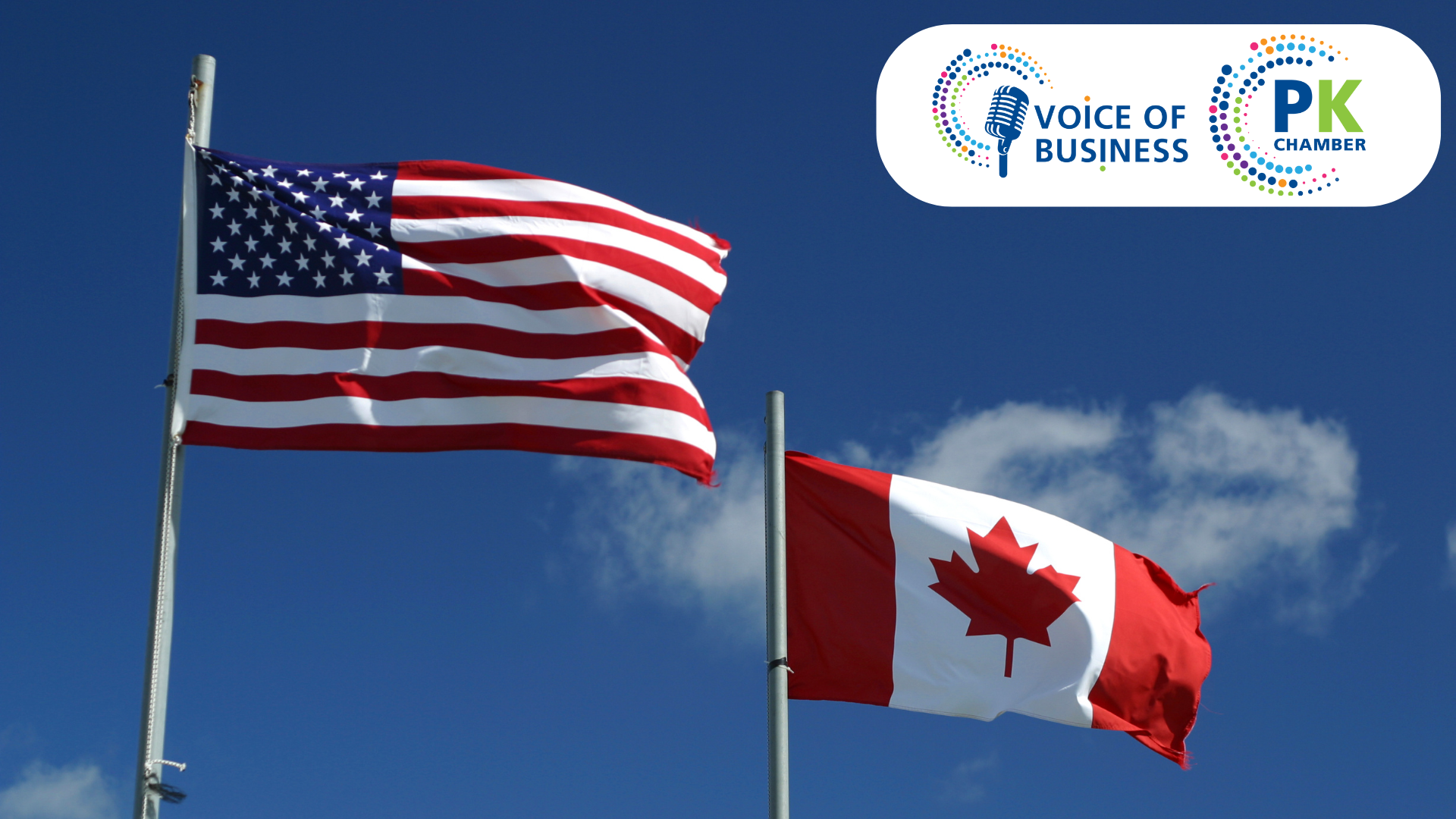Peterborough Blogs
Free Panel Event For Businesses Regarding U.S. Tariff-Proofing to Run March 4
/Business owners across Peterborough and the County are invited to attend a panel, ‘Bridging the Divide: Future-Proofing Your Business Against U.S. Tariffs’ to help local businesses navigate the challenges posed by shifting trade policies, announced on Tuesday.
Photo courtesy of the Peterborough and the Kawarthas Chamber of Commerce.
The event is hosted by Community Futures Peterborough (CFP), the Peterborough and the Kawarthas Chamber of Commerce and the Peterborough Downtown Business Improvement Association.
The free event runs on March 4 at Market Hall, with doors opening at 8 a.m. Attendees to network over food and drinks before programming begins at 8:30 a.m. The panel discussion will focus on the impact of U.S. tariffs, changes in consumer buying habits and effective strategies for businesses to mitigate risks and adapt to new trade realities, according to Devon Girard, CFP executive director.
“The impact of U.S. tariffs is being felt across our region, and business owners are facing new challenges that require immediate attention,” she said. “We recognized the urgency of this issue and felt it was essential to bring together experts in trade, supply chain management, and finance to provide actionable insights. This panel is a direct response to the concerns we’ve heard from local businesses, and we’re committed to equipping them with the knowledge and strategies they need to navigate these changes successfully.”
The event will begin with opening remarks from Girard, Joel Wiebe of the Peterborough Chamber and Bonnie Clark, Peterborough County Warden. A panel will feature industry experts, including Bob Armstrong, President of Armstrong Trade and Logistics Advisory Services; Andrea Parkes, Professor of Supply Chain at Fleming College; and Sherry Hill, CFO of Peterboro Matboards and Secretary of the Kawartha Manufacturers Association.
“Canada’s supply chains are critical to our country’s economic success but are under constant upheaval due to the complexity of the supply chain, consumers changing purchasing habits, government interventions, wars and labour shortages,” said Armstrong. “Our largest trade flows are South-North-South with our largest trading partner the USA. Will we see a new, larger flow of goods across Canada east to west, west to east as Canadians trade more with each other? Will Canada increase its exports and imports with the Far East and the EU? That can change supply chain patterns too,” he added.
Panellists will explore key topics such as how tariffs disrupt supply chains, strategies for diversifying suppliers, the impact of trade barriers on local businesses and new market opportunities for Canadian exporters throughout the discussion. Local business owners will also share firsthand experiences on how tariffs are affecting their operations and what steps they are taking to adapt to our rapidly changing environment.
“Our local economy is disrupted,” said Wiebe. “Peterborough sells more than $580 million in goods to the US and businesses here rely on American companies for the goods and materials they produce and sell. This is an opportunity to address the risks in our supply chain.”
Registration for the event can be found at CFP’s website.
Engage with us on social media on Twitter, Instagram, Facebook, Tiktok, Youtube and LinkedIn. Write to us at tips@ptbocanada.com. Sign up for our newsletter here.
Voice of Business: Reconsidering Interprovincial Trade Barriers
/The temporary implementation of U.S. tariffs by President Donald Trump, followed by a pause until March 4, has reignited discussions about improving domestic trade.
In response, the Ontario Chamber of Commerce, along with many other provincial chambers, has renewed its call to remove interprovincial trade barriers.
With the U.S. being Canada’s largest trading partner and thousands of Canadian jobs relying on the American economy, it is crucial to look inward and mitigate potential risks associated with a trade war. The pause in tariffs has forced Canada to rethink its trade strategy, leading to efforts to strengthen relationships with European and other global partners. Amidst these shifts, calls to eliminate interprovincial trade barriers have gained momentum, as doing so could add an estimated $200 billion to annual GDP.
The debate over interprovincial trade barriers has persisted for decades, but recent U.S. trade policies have intensified the urgency. While removing these barriers may not replace Canada’s trade relationship with the U.S., experts argue that it is a crucial step toward economic resilience. This edition of Voice of Business will examine the impact of interprovincial trade barriers, current restrictions between provinces, and the future of interprovincial trade and its benefits for businesses.
Interprovincial trade barriers create inefficiencies in multiple industries, including product sales, trucking regulations, and labour mobility (licensing and certification requirements). One of the most well-known examples is alcohol sales. Each province has its own regulations for selling alcohol, making it difficult for businesses to operate across borders. These barriers increase compliance costs and reduce business opportunities.
For instance, in Quebec, only the provincial alcohol corporation, Société des Alcools du Québec (SAQ), has the legal authority to import alcohol. Even individuals bringing alcohol into Quebec must file an online declaration form, regardless of whether the alcohol is a gift or personal purchase. This creates significant hurdles for Ontario businesses trying to expand into Quebec.
Another major barrier is trucking regulations. Different provinces impose varying restrictions on truck weights and loads, limiting the ability of businesses to transport goods efficiently. For example, Nova Scotia enforces strict weight limits, restricting certain types of cargo from entering the province. Additionally, direct-to-consumer shipping alcohol is restricted in several provinces, further complicating interprovincial commerce. While these regulations are often intended to protect local businesses, they ultimately hinder economic growth and business expansion.
The federal government has acknowledged these challenges and has expressed its commitment to addressing them. However, because trade regulations fall under provincial jurisdiction, the responsibility lies with the provinces to harmonize rules and ease restrictions. Some progress has been made. In 2017, the federal, provincial, and territorial governments signed the Canadian Free Trade Agreement (CFTA), committing to reducing trade barriers. In early 2024, agreements were approved for 17 of the 30 restricted sectors, but key barriers remain. Provinces have taken independent steps, such as Alberta and British Columbia reducing alcohol trade restrictions and the Atlantic Growth Strategy (launched in 2016) harmonizing licensing requirements for skilled trades.
With new U.S. tariffs on steel and aluminum already in place and more expected in early March, Canada must act quickly to support businesses. By removing interprovincial trade barriers, businesses can offset some of the negative effects of external trade restrictions and strengthen the domestic economy. Minister of Transport, Anita Anand has suggested that trade barriers could be eliminated within a month if provinces collaborate. However, achieving meaningful progress requires a coordinated effort to streamline trade regulations, standardize trucking policies, and improve labour mobility.
By fostering a truly open domestic market, Canada can better support its businesses and ensure long-term economic growth—regardless of external pressures.
Content provided by the Peterborough and the Kawarthas Chamber of Commerce.
Engage with us on social media on Twitter, Instagram, Facebook and Tiktok. Write to us at tips@ptbocanada.com. Sign up for PTBOBuzz newsletter here.
Voice of Business: Addressing Ontario’s Family Doctor Shortage: Where Healthcare, Governance, and Business Intersect
/This week on the Voice of Business, we’re tackling an issue that many in Ontario are familiar with, including right here in Peterborough: the growing shortage of family doctors.
It’s not just about healthcare—this is something that impacts local businesses, the economy, and thousands of people in our community.
Currently about 2.5 million people don’t have access to a family doctor. Locally, it’s estimated that by next year, around 63,000 people in Peterborough will be in the same boat. Municipalities everywhere are struggling to recruit doctors, often competing in what some have compared to a “Hunger Games” style race—where only the communities with the biggest budgets and best incentives can win. Physician recruiting and retaining is thus a multifaceted issue with several intersecting factors that requires focused policy attention.
With a growing number of people without family physicians we can see the effects where this can unintentionally strain local hospitals. A study by Ontario’s Auditor General found that one in five patients goes to the hospital simply because they don’t have a family doctor. This leads to pressure on emergency services, forcing patients with severe medical needs to wait longer while lower-acuity cases backlog the system. It’s a reminder of what happens when there is an unprecedented family physician shortage.
While many municipalities work to compile family physician recruit teams, it remains a challenge as family medicine can be seen as a daunting and unattractive option for medical students. The Ontario Medical Association (OMA) has shed light on this trend: as of 2024, family physicians are paying between 30% and 50% of their income on overhead expenses. For any business owner, seeing nearly half your revenue absorbed into overhead costs is uninspiring—this is no different for family doctors.
The number of family physician vacancies highlight this trend further. Family physician vacancies rose from 30 in 2020 to 108 in 2024. Out of the 560 residency positions for family medicine that year, 108 went unfilled. These vacancies highlight how family medicine is becoming less appealing, not just financially but in terms of workload.
Administrative burdens further exacerbate the issue. Family doctors spend an average of 19 hours per week on paperwork—40% of their total working time. Tasks like processing sick notes consume a large portion of a physician’s work. While the Ontario government has waived the need for sick notes for absences up to three days, many doctors continue to call for their complete removal. This reasoning lies behind the idea that every minute spent on unnecessary paperwork is a minute they could be spending with patients.
Then there’s licensing. Locally, a study from a municipality in Peterborough County found that licensing family physicians can take up to four months. For a region where over 36,000 residents lack a family doctor, streamlining these processes is crucial. Quicker licensing would mean faster access to care and less reliance on overburdened emergency departments.
Peterborough County and the city of Peterborough are doing their part by hiring physician recruitment coordinators to attract more family doctors. Yet, smaller communities like ours face a unique challenge competing with hundreds of other municipalities. Some municipalities such as Bracebridge, St. Catherines and Brockton have attributed this to a “hunger games” approach where the municipality with deeper pockets can present more attractive packages, leaving smaller areas like Peterborough at a disadvantage.
All these challenges point to a bigger issue: the need for decisive government action. While Ontario has made progress—like easing the burden of sick notes for short absences more still needs to be done. Following communication with the city of Peterborough and Peterborough County on their goals to help in recruiting family physicians, the following measures were discussed below:
· Address overhead expenses to make family medicine a more viable and attractive career choice.
· Set fair recruitment standards to create equal opportunities for municipalities to recruit family physicians.
· Streamlining administrative processes to accelerate the timeline for family physicians to receive their licensing to practice.
At the end of the day, family physicians aren’t just healthcare providers—they’re business owners too. Their well-being directly impacts our workforce, employers, and business owners. A stronger healthcare foundation means a stronger community for all of us.
Content provided by the Peterborough and the Kawarthas Chamber of Commerce.
Engage with us on social media on Twitter, Instagram, Facebook and Tiktok. Write to us at tips@ptbocanada.com. Sign up for PTBOBuzz newsletter here.
Peterborough Chamber to Launch "Igniting Emerging Leaders" to Support and Network Young Professionals
/The Peterborough and the Kawarthas Chamber of Commerce is launching ‘Igniting Emerging Leaders – Young Professionals Group’ to help network young professionals under 40 at Shorelines Casino on Jan. 29.
Photo courtesy of the Peterborough and the Kawarthas Chamber of Commerce.
The free event is open and intended for emerging business leaders under 40 to receive new opportunities to connect and develop through the Young Professionals Group. It runs from 7 p.m to 8:30 p.m.
The group will offer opportunities to connect, fun activities, and insightful speakers on relevant and timely themes such as building a personal brand in the digital age says Nigel Broersma, Chamber director of business development.
“We are thrilled to launch our new Young Professionals program, which is a direct response to feedback from our members,” he said. “This initiative will feature quarterly meetings that blend social interaction, networking, engaging activities, and a speaker series. It’s an excellent opportunity for young professionals to learn, grow their knowledge, and build meaningful connections within our vibrant and expanding business community.”
Registration is online. The Young Professionals Group will meet quarterly at a different regional business. Attendees will be allowed to grow their relationships, ask questions and learn new skills.
Engage with us on social media on Twitter, Instagram, Facebook, Tiktok, Youtube and LinkedIn. Write to us at tips@ptbocanada.com. Sign up for our newsletter here.
Voice of Business: The Uncertain Future: A Look Into the Implications of U.S Tariffs and a Looming Election
/Recent months have seen a turbulent political climate in Canada and challenges in the relationship with the U.S.
This week's VOB explores the implications of proposed tariffs on Canadians and Canadian businesses, the historical context of similar situations and the potential economic fallout of this looming issue.
In November 2024, President-Elect Donald Trump announced his intent to impose a 25 per cent tariff on all goods from Canada and Mexico unless both countries address issues related to drug and migrant flows across the border. In response, Canada pledged $1.3 billion in new spending for border security although legislative action on this plan is stalled due to Parliament’s prorogation until March 24, leaving key details in limbo.
The potential consequences of these tariffs are evident. Experts estimate that Canada’s GDP could decrease by more than 2.4 per cent, contributing to significant inflationary pressures and the loss of as many as 1.5 million jobs. The impact wouldn’t be isolated to Canada—the U.S. is also projected to see a 1 per cent reduction in its GDP if these measures proceed. These tariffs would affect manufacturers, employers, and consumers alike, creating widespread disruption and economic strain.
This is not Canada’s first experience with Trump-era tariffs. In 2018, he imposed a 25 per cent tariff on steel and 10 per cent on aluminum products. Canada responded with its own $16 billion in tariffs on U.S. goods before both nations reached an agreement in 2019. A similar cycle repeated in 2020 with the introduction of additional 10 per cent tariffs by the U.S., countered by Canada. Prime Minister Justin Trudeau has signalled that Canada will implement countermeasures if the proposed January 2025 tariffs go into effect.
The automotive sector, which sources 20 per cent of its inputs from the U.S., is one of the industries most vulnerable to cost increases. Other affected sectors include energy, chemical and plastic manufacturing, forestry products, and machinery—all susceptible to supply chain disruptions and rising costs. Small and medium-sized businesses, which account for 40 per cent of Canada’s exports to the U.S., would face similar challenges, with tighter margins and declining sales potentially leading to widespread job losses. In Ontario alone, the potential toll could reach 500,000 jobs.
In preparation, the Canadian government is considering retaliatory tariffs, targeting products such as toilet paper and orange juice, although specific measures remain under development. This situation, experts suggest, is part of Trump’s broader negotiation strategy—a high-pressure tactic aimed at achieving stricter border security measures by leveraging extreme demands.
While the federal government’s response is on hold due to Parliament’s prorogation, several provinces have proactively bolstered border security resources. For businesses, preparing for the potential tariffs is vital. Andrea Schaffer, an expert in international trade, recommends business conduct a “thorough supply chain assessment to identify risks, planning for both 10 per cent and 25 per cent tariff scenarios, building six months of cash reserves, and renegotiating contracts to include tariff provisions and limit financial exposure.”
Though businesses can take steps to mitigate the potential impacts, support from all levels of government will be critical in navigating the challenges ahead. The uncertainty surrounding these tariffs underscores the importance of proactive planning and coordinated action to protect the economy and the workforce from their far-reaching effects.
Content provided by the Peterborough and the Kawarthas Chamber of Commerce.
Engage with us on social media on Twitter, Instagram, Facebook and Tiktok. Write to us at tips@ptbocanada.com. Sign up for PTBOBuzz newsletter here.
Voice of Business: Navigating the Holiday Tax Break
/This past month has been challenging for businesses and organizations across Canada.
With postal strikes affecting businesses across Ontario, we’re diving into some news that could shake up our holidays for businesses and shoppers across Canada. Starting this Saturday, December 14th, 2024, the government is rolling out a GST/HST tax exemption on various products until February 15th, 2025.
The GST/HST offers zero rate taxes on multiple products. The following products are:
Food
Beverages
Restaurants, catering, and other food or drink establishments
Children’s Clothing and Footwear
Children’s diapers
Children’s car seats
Children’s Toys
Jigsaw Puzzles
Video Game consoles
Physical Books
Printed Newspapers
Christmas and Similar decorative trees
Now, this may seem like a win for consumers. No tax means lower prices and we could see increased spending, but we don’t know the whole impact on businesses and how this pressure to comply with new tax rules takes its toll at a time when shipping is delayed from ongoing postal strikes. While customers might enjoy the savings of an estimated total of $1.7 billion, businesses are stressed and scrambling to get ready. According to the Canadian Federation of Independent Business (CFIB), many small businesses call this tax break a headache. A survey from 3,500 small businesses found that 75 per cent of small firms expect it’ll cost them about $1,000 just to reprogram their systems to handle the exemption. And 65% said there’s not enough time to get everything in place before the deadline.
With the perceived benefit for consumers, businesses will still have to go through the tedious task of updating their systems. This tedious task could update their computing systems to apply zero-tax to the products listed above.
Some industries, such as hospitality, will have to go through more tedious tasks than others. This involves distinguishing between selecting the alcohol eligible for GST/HST relief because there are specific alcoholic beverages eligible for tax relief and some that are not. According to the CRA, beer and malt beverages (canned or bottled beer, pitches of beer) qualify. Wine, cider and sake (including fortified) that are 22.9 per cent alcohol by volume or less. And/or Spirit cooler and premixed alcoholic beverages that are 7 per cent ABV or less also qualify.
The items that would not qualify are alcoholic spirits and liqueurs, including cocktails with spirits that would not qualify. For example, a sangria, including wine and rum, would not qualify. Beverages sold from a vending machine also are not eligible. Examples like these create an additional burden for businesses. Another burden is that businesses will additionally have to revert to their original systems after the tax relief period.
There are also some confusing rules around returns. For instance, a customer buys something now during the tax break, then returns it and repurchases it later. That could mean extra fees for businesses handling those transactions through credit cards. And let’s not forget some of the confusion around qualifying items—like age limits for children’s products. Businesses will need to sort through these nuances, which could lead to even more confusion. This is not ideal for already stretched small businesses preparing for the busy holidays.
While the government hopes this holiday tax break will boost consumer spending, not everyone is convinced. Only 4 per cent of small business owners surveyed by the CFIB think it’ll lead to stronger sales. For many, the costs and logistical challenges seem to outweigh the potential benefits. As Saturday looms closer, this GST/HST relief is inevitable. Still, we can only hope this holiday relief will increase sales for our local businesses and make the tedious work worth doing.
If you’re a business owner feeling overwhelmed, there are resources to help you navigate this. You can call the CRA’s GST/HST inquiries line (1-800-959-8287 for English, 1-800-959-8296 for French) or check out the CRA’s webpage here.
Content provided by the Peterborough and the Kawarthas Chamber of Commerce.
Engage with us on social media on Twitter, Instagram, Facebook and Tiktok. Write to us at tips@ptbocanada.com. Sign up for PTBOBuzz newsletter here.
Voice of Business: Second-Annual Mayor's Breakfast
/Addressing the Elephants in the Room: From Development Charges, Physician Recruitment, Tax Increases and More!
Last week, your local Chamber of Commerce brought together our local business and political leaders, Mayor Jeff Leal and Jasbir Raina, the Chief Administrative officer (CAO). This was the second annual Mayor's Breakfast, with a packed house at the Peterborough Golf and Country Club. This meeting covered important municipal matters, from increasing development charges and tax rates to physician recruitment and MAT tax.
With this meeting expected to be heated, Leal and Raina dove into the reasoning behind the proposed budget cuts. As you may know, last week, the city council proposed to cut funding by 25 per cent for various community organizations rather than raising our tax rates. A week later, council rejected most of the proposed budget cuts. Leal brought up how instead of applying budget cuts, he asked the "big three” to reassess their budget asks. These organizations were the Police Services Board, Peterborough County-City Paramedics, and Peterborough Public Health. Rather than raising our tax rates, Leal wants to make this budget work by asking the three organizations to reassess their funding requests.
Raina referred to his experience in Mississauga, where he learned the ropes of accurate municipal budgeting. He reasoned that a municipality must operate with a large tax base. Raina mentioned that "municipalities cannot function and expect to grow with smaller tax bases, specifically Band-Aid budgets." Raina pointed to the many completed roads and ongoing projects adequately funded through tax increases.
Leal also touched on cross-border servicing and physician recruitment. With little industrial land left in Peterborough, this is a big concern if we seek to grow our industrial sector locally. Leal went over how the city has proposed to work with other municipalities in cross-border servicing, where industrial lands would be co-managed. This would benefit the city and the neighboring municipality and bring more businesses and employment to our area. On a physician recruitment note, Peterborough currently has 32,000 people without a doctor, which is a complex situation. Leal touched on this complexity in the city's plan to help bring in more family physicians. The "Bring Them Home" campaign would seek to bring back overseas Peterborian medical students in Ireland to practice at home in Peterborough.
The next elephant in the room was the proposal to increase development charges. One audience member asked how the city expects to spur development with these high increases. Raina responded to this comment, saying, “Every house added to the city is putting pressure on the community, and in accommodating this growth, the community must bear the costs.” Although this makes it seem that development charges are necessary to accommodate growth, many developers are still concerned with this cost increase as it will make it more expensive to build and will pass on to the consumer, as one audience member pointed out. On a side note, the Chamber will address the proposed high increases in development charges with our local Peterborough and Kawarthas Home Builders Association.
The next hot topic was our Municipal Accommodation Tax (MAT), implemented in 2019, in which 50 per cent of its revenue will fund a new city-managed tourism entity. An audience member asked about the city's plan for this. Raina highlighted that the MAT tax would strictly reinvest in tourism development, and the work to establish the city's tourism entity is still a novel proposal and a work in progress. Raina also mentioned the progress in the MAT tax funding projects, such as the new arena, and how this MAT tax can continue to rejuvenate downtown.
Moving on to successful city initiatives, Leal showcased the recent success of the city's green waste initiative. Members of the audience were pleased to hear about creating a plan to expand green waste to businesses. This green waste initiative helped the city see great benefits in reducing landfill use and extending its life. Leal also mentioned that the plan to provide green waste management services could occur in the next calendar year.
This Q&A was jam-packed with sensitive but necessary discussions regarding taxpayer increases and operating challenges. This was a great opportunity for businesses to voice their concerns and have our public servants and mayor hear them. Having this dialogue in uncertain times amidst proposed tax increases is refreshing to see. This Q&A provided much-needed insight into the city's rationale for the following calendar year. This breakfast closed off with remarks from Leal and Raina expressing that to build Peterborough, it will take a unified approach. While true, this unified approach should not come at the expense of our local businesses. We hope our city can hear these concerns addressed at our Mayor's Breakfast and that next year's proposed plans reflect the feedback they received.
Content provided by the Peterborough and the Kawarthas Chamber of Commerce.
Engage with us on social media on Twitter, Instagram, Facebook and Tiktok. Write to us at tips@ptbocanada.com. Sign up for PTBOBuzz newsletter here.
Voice of Business: Canada’s International Student Cuts: A Double-Edged Sword
/This past September, the Canadian government announced another 10 per cent cut to international student permits.
This isn’t the first cut either. Earlier this year, there was already a 35 per cent reduction in student visas, plus a cap of 364,000 visas this fall (down from last year’s 560,000). So, what’s behind these numbers, and what does it mean for Canada? With all these restrictions on international students, there is a lot to unpack—and some potential serious consequences.
The conversation around international students has been heating up, especially with Canada’s housing crisis and labour shortages thrown into the mix. We’re seeing strong opinions on both sides. On one hand, there’s a group that says Canada’s infrastructure just can’t handle the volume of international students coming in. On the opposing side, national student associations argue that international students are wrongly blamed for the housing crisis. Cutting their numbers, they say, also hits universities hard, slashing a vital revenue stream.
And they’re not wrong—Canada’s colleges and universities rely on international student fees, which are much higher than domestic ones. For example, Fanshawe College recently reported they’re expecting a whopping 39 per cent cut in international students next January, with a 47 per cent drop in first-year international students alone. The Council of Ontario Universities also are projecting a loss of nearly $1 billion in revenue over two years with the drop in international student enrollment. Considering the average cost for an international student is around $36,000 a year, these reductions could severely impact funding for our post-secondary institutions.
The reliance on international students has sparked some tough questions: are schools too dependent on these higher fees to make up for gaps in public funding? And what happens when this revenue source shrinks? Some wonder if Canadian institutions should rethink their business models and find a more balanced way to fund education without leaning so heavily on international students.
There’s another layer to all this: international students contribute more than just tuition fees. They’re a crucial part of Canada’s workforce, particularly in the hospitality sector. According to Statistics Canada, international students make up around 4.6 per cent of that industry—a big deal in a sector that’s facing labor shortages. Plus, the Canadian Bureau for International Education shows that 70 per cent of international students indicated they want to stay and work in Canada after graduation, which could further add to our growing talent pool. Their economic impact also extends beyond tuition, who support local businesses and contribute millions to the economy in consumer spending.
But, of course, we can’t ignore the housing issue. With more than a million international students in Canada, and vacancy rates as low as 1.7 per cent in Ontario, housing is in high demand. More students mean more pressure on an already tight housing supply, which many Canadians feel directly. This is where the government’s policy shift could ease some of that strain, but it’s a double-edged sword. Fewer international students may help with housing, but it could significantly reduce revenues for post-secondary institutions and even lead to staff layoffs.
Ultimately, this situation highlights the complexity of relying heavily on international students. The recent policy changes make it clear: this isn’t just about the students. It’s about sustainable planning and strategies that support Canada’s needs, whether it’s in housing, education funding, or labor supply. Moving forward, we can only hope that these policy adjustments drive further investments in the infrastructure and resources needed to make Canada a stable place for everyone—both local and international residents.
Content provided by the Peterborough and the Kawarthas Chamber of Commerce.
Engage with us on social media on Twitter, Instagram, Facebook and Tiktok. Write to us at tips@ptbocanada.com. Sign up for PTBOBuzz newsletter here.
Peterborough and the Kawartha Chamber of Commerce Announce Business Excellence Awards Recipients
/The Peterborough and the Kawartha Chamber of Commerce handed out its 2024 Business Excellence Awards at a ceremony held at Showplace Performance Centre on Tuesday night.
Phillip Jolicoeur (middle) with his family, announced as the Business Citizens of the Year. Photo courtesy of the Peterborough and the Kawartha Chamber of Commernce.
The awards are designed to publicly recognize and honour local businesses with a passion for excellence.
Almost 50 businesses and individuals were profiled in 22 categories, with recipients announced live on stage.
The following are the nominees and award recipients:
4-Under-40 Profiles, in memory of Kathy Windrem
Dr. Taylor Bonner
Joe Curry
Hillary Flood
Dylan Radcliffe
Businesswomen of the Year
Entrepreneur
Rosalea Terry of nectar co. (Recipient)
Organization
Heidi Popov of Kawartha Gymnastics (Recipient)
Business Citizen of the Year
Phillip Jolicoeur of PJ The Marketing Guy, Phillip Jolicoeur Entertainment, Photo Booth Fun (Recipient)
Business Student Leadership Prizes (winners listed)
Ali Jammal (Trent University)
Joylyn Johnson D Souza (Trent University)
Swarna Latha Mareedu (Fleming College)
Commercial Development or Renovation
Ashburnham Realty (The Railyard Development)
The Canadian Canoe Museum (Recipient)
Holmes Riseley LLP (823 Park St. S.)
Customer First
The Boardwalk Board Game Lounge
Couture Candy (Recipient)
McLeod's EcoWater
Employer of the Year
Engage Engineering
Gauvreau Accounting Tax Law Advisory (Recipient
Entrepreneurial Spirit
Green Street Inc.
nectar co.
Wanderlight Alpaca Experience (Recipient)
Peterborough County Farm Family of the Year (winners listed)
• Scott, Paula, Jason & Shelby Cornish (Whiskey Lane Livestock)
Green Initiatives
Camp Kawartha (Recipient)
Cheeks Ahoy
Dietrich Homes
Health & Wellness
Acceptance Nurse Psychotherapy
Flow Spa (Recipient)
Trent Health in Motion
Hospitality
Levantine Grill
Millbrook Mercantile (Recipient)
Local Focus
Lang Pioneer Village Museum (Recipient)
Market Hall Performing Arts Centre
OmniWorx Design
Marketing & Promotion
Cottage Country Lifestyle Magazine
Harmony for Healing
nectar co. - The Viral Keepsake Campaign (Recipient)
Micro Business
The Chocolate Rabbit (Recipient)
Millbrook Mercantile
Peterborough Disability Tax Services
Immigrant Entrepreneur of the Year
Sama Noor Yousafzai (Goodies on Mews)
Not-for-Profit
Five Counties Children's Centre
Habitat for Humanity Peterborough & Kawartha Region – (Recipient)
Kawartha Gymnastics
Professional Services
Acceptance Nurse Psychotherapy (Recipient)
Gauvreau Accounting Tax Law Advisory
Holmes Riseley LLP
Retail
Dan Joyce's Retailing Limited
Paris Marine (Recipient)
Shop The Lake Inc.
Skilled Trades
R & M Smith Contracting (Recipient)
Tom's Heating and Cooling
Tourism
Beachwood Resort
Kawartha Country Wines
Lang Pioneer Village Museum (Recipient)



















